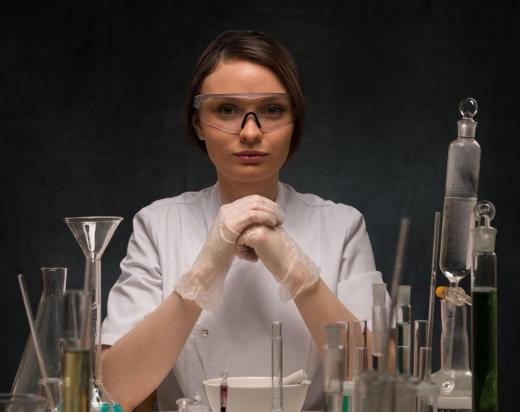What Is Gas Chromatography?
 Mary McMahon
Mary McMahon
Gas chromatography is an analytical technique used to collect information about the chemical components of a gas sample. Not all samples are amenable to this type of analysis, which requires heating the sample to vaporize it. Some may degrade under these conditions and can yield inaccurate or incomplete results. In cases where it is appropriate to use this technique, several passes may be necessary to gather all the necessary data, depending on the sample and the reason for the testing.
In this procedure, a chemist injects a small amount of a sample into a port which quickly heats it, well past the boiling point of the mixture. The gas chromatograph pumps an inert carrier gas through the sample, pushing it into a column. As it moves through the column, the components separate out because they move at different rates once they are vaporized. This allows them to pass through a detector at different times.

The detector triggers a recorder to note the presence of particular gases. Some detectors used in gas chromatography are sensitive to a specific compound and will not react to others, allowing scientists to determine if a particular chemical is in a sample, and at what concentration. Others have a broader mechanism of action and can note the presence of several chemicals in a single test. Gas chromatography is not infallible, as it is possible for chemicals to hide behind traces of each other, and another pass may be needed to clarify the components of a mix and their concentrations.
One use for gas chromatography is in purity testing. It can also help people determine the concentrations of different compounds in a mixed sample. Some chemists use it for identification of unknown samples. This process is often featured on forensic television shows, where it typically takes seconds and yields very precise results. In chemistry labs, gas chromatography may take an hour or more for the first pass, and more testing can be necessary to collect all the necessary information.
This process must be tightly controlled to yield the most reliable and effective results. Temperature control is critical to keep the sample within the right range, and the equipment needs to be calibrated and cleaned between samples. Many labs provide a manual with detailed instructions on policies and procedures to ensure that testing is consistent, and all personnel know how to handle the equipment. In the event of a dispute or question about a sample, the lab may send the sample to another facility for verification, or could request a technician visit to confirm that the gas chromatograph is calibrated and working correctly.
AS FEATURED ON:
AS FEATURED ON:











Discuss this Article
Post your comments